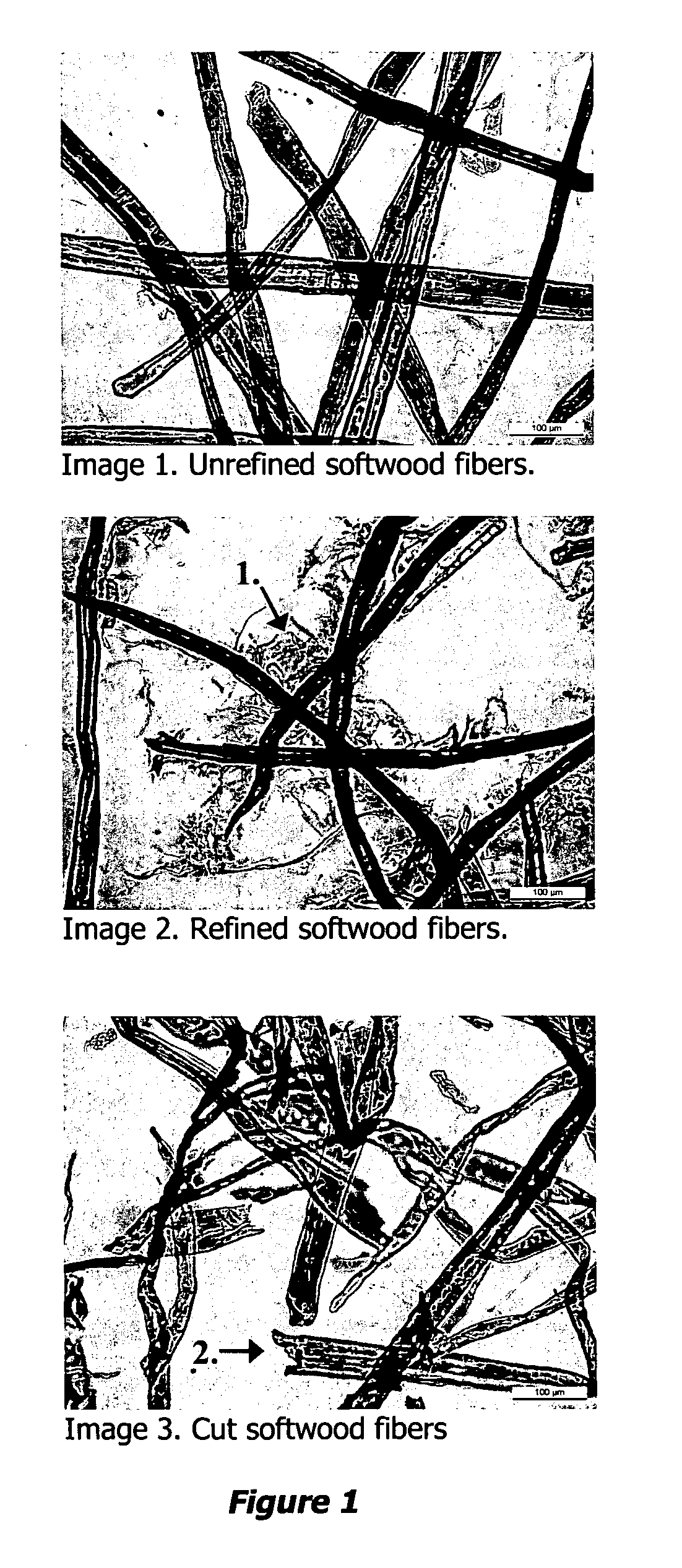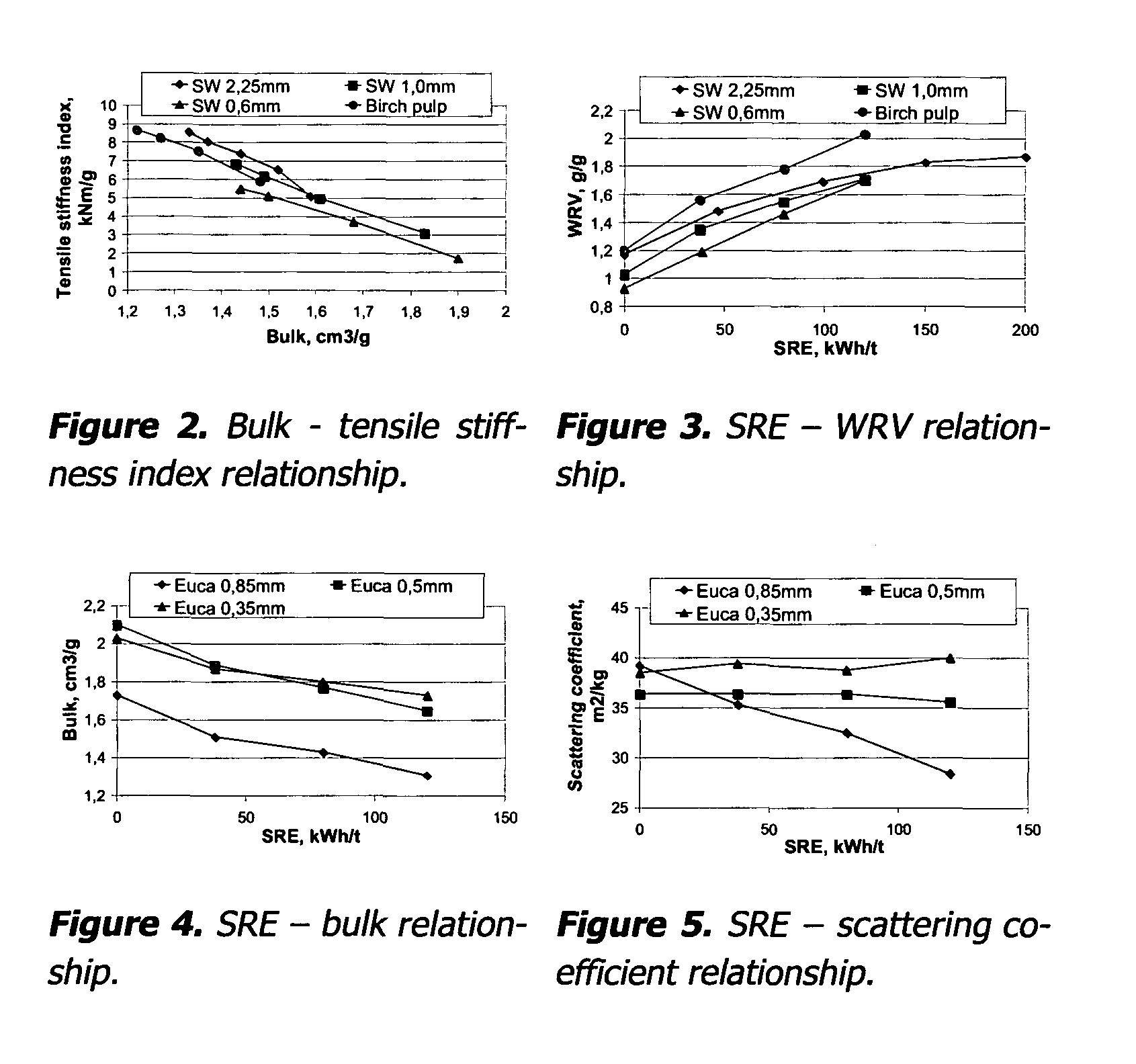Method of making paper
a papermaking and paper board technology, applied in the field of paper making technology, can solve the problems of poor pulp properties, adversely affecting the papermaking potential of defibered pulp, and affecting the production efficiency so as to improve the quality of paper and paper board products, shorten fibers, and improve production efficiency
- Summary
- Abstract
- Description
- Claims
- Application Information
AI Technical Summary
Benefits of technology
Problems solved by technology
Method used
Image
Examples
example 1
[0041]Dried softwood (SW) pulp (mill dried pulp, mainly from pine, average fiber length 2.25 mm) was cut to average fiber length of 1.0 mm and 0.6 mm by using slot dimensions 6 mm and 2 mm respectively. The pulps were treated two times. The cut pulps were refined like hardwood pulps with a specific edge load 0.5 J / m.
[0042]The structure of the fibers was studies with a light transmission microscope. Pictures are shown in FIG. 1. Image 1 shows untreated fibers, Image 2 refined uncut fibers, and Image 3 cut fibers.
[0043]As shown in FIG. 1, the fiber form of refined fibers is clearly different from unrefined fibers (collapsed, deformations etc.). External fibrillation can be clearly seen in the fiber surface (1). Cutting (2.) has occurred relatively sharply. The cutting has not fibrillated the fibers.
[0044]Compared to reference SW pulp of fiber length 2.25 mm, cut SW pulps have lower water retention value (improved dewatering) and higher bulk (FIGS. 3 & 4). As ca...
example 2
Cutting of Eucalyptus Pulp
[0046]Dried eucalyptus (euca) pulp (mill dried pulp, average fiber length 0.85 mm) was cut to average fiber length of 0.5 mm and 0.35 mm by using slot dimensions 2 mm and 1 mm respectively. The pulps were treated once. Both reference and cut pulps were refined with specific edge load 0.4 J / m. Cut eucalyptus pulps have clearly better dewatering (lower WRV and SR number) and higher bulk (FIG. 4). Optical properties (light scattering, opacity and brightness) do not decrease in refining contrary to reference pulps (FIG. 5). Strength properties (e.g. tensile stiffness index) are lower for cut pulps, but it can be partly compensated by more intense refining if needed. It might be possible to improve quality of some paper products and improve dewatering at the paper machine by using cut eucalyptus pulp instead of regular eucalyptus pulp.
example 3
Comparison Between Cut Fibers and Refined SW Fibers
[0047]
TABLE 1Comparison between cut SW fibers and unrefined and refined SW fibersCutCutSW pulp refinedSW pulp refinedSW pulpSW pulpSW pulpSW pulpin LC-refinerSW pulpin LC-refinerFiber length (l), mm2.2510.62.252.2021.2Specific energy consumption0000150050in refining, kWh / tSR number15151515281519CSF, ml660660640660430630550WRV, g / g1.171.030.921.171.83Bulk, cm3 / g1.591.831.821.591.371.691.54Tensile index, Nm / g4218114292
[0048]Table 1 shows the impact on pulp-quality of the cutting process according to the invention compared to conventional LC refining and high impact LC-refining.
[0049]The fiber length of SW pulp can be decreased to ca. 1.2 mm with conventional LC refining. However, conventional LC refining gives rise to an increase in SR number (at least 25%) and a decrease in bulk (at least 9%). A further problem when the fiber length is decreased in conventional refining of pulp is that the refiner plates are quickly worn and that the...
PUM
| Property | Measurement | Unit |
|---|---|---|
| lengths | aaaaa | aaaaa |
| tensile strength | aaaaa | aaaaa |
| length | aaaaa | aaaaa |
Abstract
Description
Claims
Application Information
 Login to View More
Login to View More - R&D
- Intellectual Property
- Life Sciences
- Materials
- Tech Scout
- Unparalleled Data Quality
- Higher Quality Content
- 60% Fewer Hallucinations
Browse by: Latest US Patents, China's latest patents, Technical Efficacy Thesaurus, Application Domain, Technology Topic, Popular Technical Reports.
© 2025 PatSnap. All rights reserved.Legal|Privacy policy|Modern Slavery Act Transparency Statement|Sitemap|About US| Contact US: help@patsnap.com


